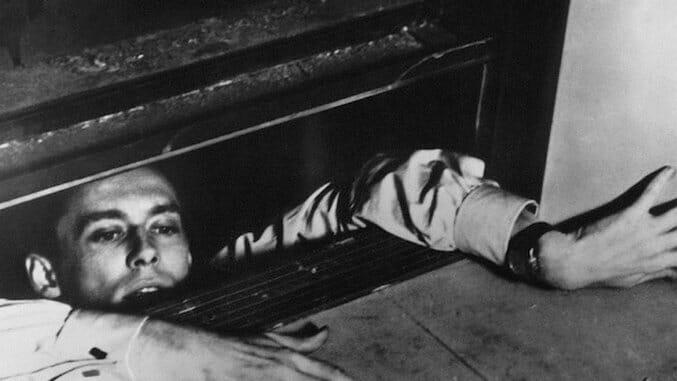
“You know that the public always likes to be one jump ahead of the story. They like to feel they know what’s coming next. So you deliberately play upon this fact to control their thoughts.” So said Alfred Hitchcock to François Truffaut regarding his approach to narrative in Psycho in the latter’s famous 1967 book-length interview of the Master of Suspense. “You turn the viewer in one direction and then in another; you keep him as far as possible from what’s actually going to happen.” Such a ruthless toying around with audience expectations marks more or less the opposite of Louis Malle’s approach in Elevator to the Gallows—a film in which the audience is consistently ahead of its characters, grasping circumstances that none of the people on screen are either able or willing to comprehend. The experiencing of watching Malle’s 1958 debut is akin to that of watching a preordained outcome, much like an academic thesis, work itself out, with much of the suspense residing all in the journey rather than the destination.
With a new digital restoration about to begin a nine-day theatrical run at New York’s Film Forum before playing elsewhere, one has a fresh opportunity to decide how to feel about a film so fundamentally built on viewers feeling superior to the characters and situations on screen. Elevator to the Gallows, despite its reputation as a precursor to French New Wave cinema, is an alienating experience in ways that can never be said about, say, Jean-Luc Godard’s Breathless, a noir riff with all the jazzy energy that Malle hints at only through its Miles Davis score (more on that later). Even Godard, for all his formal play, granted his carefree and duplicitous characters authentic inner lives. In Malle’s film, perhaps only Florence Carala (Jeanne Moreau)—the philandering wife of an arms dealer (Jean Wall) whom her current paramour, Julien Tavernier (Maurice Ronet), kills early on—could be said to invite our sympathy, and that arguably more to do with Moreau’s own luminous emotional transparency as an actress than anything Malle does either technically or narratively. Mostly, Elevator to the Gallows asks us to observe the fates of these characters with the detachment of a scientist closely observing a bunch of flies.
Malle, however, is so committed to the airlessness that there’s no choice but to accept it as the film’s substance. If film noir has often exuded a fatalism—a despairing sense that the world is beyond repair, and people are damned if they do and damned if they don’t—then Elevator to the Gallows imprints that perspective deep into the gut by turning dramatic irony into practically its whole aesthetic. Even before innocent flower girl Véronique (Yori Bertin) and brooding young criminal Louis (Georges Poujouly) realize it, we in the audience are already well aware that the older German couple they meet at a hotel aren’t the rubes the two younger lovers assume they are. It’s no surprise their attempt to steal the tourists’ car ends with violence.
The same goes with Florence’s nightlong search for Julien when he doesn’t show up for a date after he’s killed her husband: We see him get stuck in an elevator after a guard at his work building shuts the power down for the evening, thus allowing us to know the truth way before Florence—who assumes he’s wimped out and suspects he’s cheating on her with Véronique—discovers it for herself. Instead of being involved in these characters’ predicaments, we’re merely invited to admire the plot mechanics—which, in this context, could be seen as a way of admiring the gears of fate turning underneath these characters, all of whom are driven by varying shades of naïveté and illusions.
To a degree, Henri Decaë’s black-and-white cinematography thaws out some of the iciness, infusing the film with a visceral immediacy through use of real locations and handheld camerawork. But it’s Miles Davis’ jazz score that gives Elevator to the Gallows whatever scraps of soul it has. In the context of his career, Davis’ music for Malle’s film—which he improvised on the spot with four sidemen during recording sessions while bits of the film were projected in the background—plays as a precursor to the pioneering cool-jazz style he would perfect in his subsequent albums Milestones and, most famously, Kind of Blue. But that style—dominated mostly by slow-to-medium tempos and melancholy mood-painting—also brings to the film a mournfulness that, all by itself, instills emotional heft to its otherwise dryly intellectualized determinism. Certainly, when Florence embarks on the search for her possibly lost lover, one cannot imagine such scenes being half as affecting without Davis’ music underlining her deep sadness.
Director: Louis Malle
Writers: Roger Nimier and Louis Malle, based on Noël Calef’s novel
Starring: Jeanne Moreau, Maurice Ronet, Georges Poujouly, Yori Bertin, Charles Denner, Lino Ventura
Release Date: August 3, 2016
Kenji Fujishima is a freelance film critic, contributing to Slant Magazine, Brooklyn Magazine, The Playlist, and the Village Voice in addition to Paste. He is also Deputy Editor of Movie Mezzanine and former editor-in-chief of In Review Online. When he’s not watching movies and writing and editing film criticism, he’s trying to absorb as much music, art and literature as possible. He has not infrequently been called a “culture vulture” for that reason.